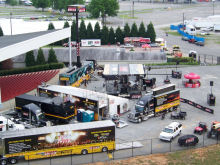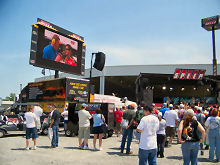May 5, 2008
By Kim Roberson
 Kim Roberson
Kim Roberson
|
If you are a NASCAR fans who either has Speed channel or has gone to a track in the last five years, then you are probably familiar with the Speed stage and shows like NASCAR Live and Trackside. The shows provide live access to the tracks for fans that are not able to be there in person. For those that are there in person, it is a chance to be on live TV and send messages home via signs….and screams.
This travelling road show is much like NASCAR itself…it packs up and moves from track to track every week. Unlike NASCAR, they are there a day earlier, and stay hours later to ensure that everyone watching at home gets as much live content as possible, starting with the very first NASCAR Live, and ending with Victory Lane after the race.
So, what goes into getting this technological adventure on the air week after week? I caught up with the Senior Account Manager for the JHE Production Group, Ray Edick, who oversees the account with Speed Channel, and was on hand at Richmond this weekend to see that everything went off as smoothly as possible.


|
“Six personnel, six vehicles, about six hours of work, typically on Wednesday, and a lot of hard work and dedication.” And that is just for the main stage...there are three stages in all: the main stage, the Race Day stage, and the Victory Lane desk. “On a typical weekend, usually Saturday, we will do what we call the flip…there are a couple of separate entities that make this whole thing work. There’s us from JHE Production Group that provides all the physical assets, your stages your tower, your TV’s your hospitality, your offices….and then there is NASCAR Media Group who comes in and they are the production side of the house…they run all of the cameras, they run the audio, you have people who come in and do lights, and all of that. When we get ready to do the flip, NASCAR Media Group folks will come in and strike the wiring, they have it down to an absolute science.”
It is no simple feat, the striking down of the stage. There are dozens of lights, cameras, and wires. Lots and lots of wires. “There’s well over a couple hundred miles of cable that runs through here and to us.” Edick explained. “We have two dedicated fiber lines that come here to us from the Television Compound. This week we are right across from them, but in places like Phoenix and Texas and Talladega, they are running anywhere from a quarter mile to a half a mile of cable down to us.”
The setup also runs on its own power system, provided by a tractor-trailer sized Caterpillar Generator. “They have a twin-pack generator which is a 45-foot trailer. Each one of these vehicles is connected to that.” The truck holds 480 gallons of diesel fuel, which is topped off every night. Even with the generator, they still have their hiccups. When they lose power “It’s not fun. There are about 30 people in here running around like chickens with their heads cut off. It’s crazy.”
The main stage, where NASCAR Live and Trackside are done, has been a work in progress since it was introduced 5 years ago. Originally, it folded out of the side of a trailer. Now, the trailer itself unfolds to make the stage we see on TV every week.
“The deck itself is 28-feet wide by 40-feet long. When it folds up…the top section comes down to normal trailer height which is 13’6”, then a lot of this stuff stays inside…the desk, the wings on the front…all that marketing deck on the side. All of that goes inside…the two floor pieces, this is all hydraulics, they fold up, the wings fold in and down.” And then you go from a TV stage to a trailer for an 18-wheeler that matches the other trailers in the convoy, with the exception of the new LCD HDTV and the tour bus.


|
Besides the Speed Stage truck, there are six other vehicles that go every weekend. There is a marketing trailer, or the tower trailer, which has a huge, 60-foot rotating tower on top advertising Speed Channel. The TV truck is a one of a kind, $1.2M vehicle that was built off of a drawing, and has a screen that raises and lowers from the center of the cab. For you truck guys, the TV truck is a 40-foot box truck custom built Coronado13-speed truck on a Freightliner straight chassis. The TV screen is made up of 35, 11mil LED panels. The production trailer is the tented vehicle where the talent comes to prepare for the show, and where guests wait before heading to the stage to be interviewed. The truck also carries all the camera work, all the audio, all the lighting, and also provides offices for management.
The Raceday trailer looks a lot like a NASCAR hauler, with two levels. The top level houses the Raceday stage, which folds up from its octagonal brick and wood look to a rectangle, and the cut-away car that Larry MacReynolds, Booty Barker, and Chad Knaus use for NASCAR Performance each week. There is a Tour Bus, which is a 43-foot Prevost XL2 bus with two slide-outs and six bunks, where people can relax and get away from the crowds, watch TV, listen to music, and get some work done away from the chaos surrounding the stages. There is also a seventh truck that is owned by Speed Channel, which was purchased for the Freightliner Truck Driver Challenge, and is used to put the NASCAR Hauler drivers through their paces. That truck is used to haul the remaining pieces of equipment to and from tracks.
Each truck has a large set-up process that goes with it, and training begins before the season does, with three days of learning how to set up and take down each of the stages, towers, and tents, and five days to learn how to operate the TV truck.
While Ray, who started working for the company four years ago, begged to be on the road crew, he started off as the motorcoach driver, and moved up to Tour Manager, and eventually on to his current job, where he isn’t required to be on the road every weekend, but now makes sure those who are on the road every weekend are ready to go and able to do their jobs to the best of their abilities. He says that people come up every weekend and ask how they can be on the crew, and Ray says while he loves the job, you have to be careful what you wish for.
“They come up here and they see all of this, they are race fans, and they see the talent coming out and they see us interacting with Jeff Gordon and Junior and Tony Stewart. These folks are like ‘Oh dude, you get to hang out with Junior…you have the best job ever!’ But it is just (a fraction) of the pie. I will not lie, this job has its perks…but what they don’t see what it took to set all this up. They don’t see that these guys do this 38 weeks of the year. They don’t see that all of these guys sleep in their truck in a bunk, and they have to shower in a shower the size of a trash can. They don’t see that they have to eat catered food every week, the catered food isn’t always great. It’s hard work. The guy who drives our stage truck has three kids under the age of ten, and right now because of the passion that he has for his job, he’s missing them growing up. The guy who drives our marketing trailer has two kids; the guy who drives the TV trailer has a son. They go into their truck every night and call home instead of going home and having their kids run up to them. They do it because they love what they do.”
But as crazy as the lifestyle is, the president of the company worries about the guys on the road, and knows he asks a lot of them. The week between Fontana and Las Vegas, the trucks are driven to the Vegas track, and then the drivers hop on a plane and head home. If a guy needs a weekend off, all they have to do is ask, and usually they will get it. A SUV is brought with the trucks every weekend so the crew can take a night and go out or go to do laundry or go buy groceries.
The crews are on the road every week that the Cup Series is on the road. They usually arrive the day before the cup teams arrive (Wednesday), and are on site for several hours after the checkered flag flies on Sunday.
There are seven vehicles that travel as part of the Speed Stage, and the men who drive those are usually home for a day and a half, at most. On a weekly basis, there are 25 people who make the stage itself work, and another 35 or 40 who work in the TV compound and make sure that everything that happens on the stages goes out to us at home. When the trucks leave Daytona in February, they head straight to Fontana, driving 24 hours straight (with two drivers rotating), and only stopping when they re-fuel. The seven vehicles don’t roll together, but tend to travel in pairs. Each truck as twin 150-gallon fuel tanks (and the trucks are environmentally friendly, running ultra-low sulfur emitting systems which are relatively pollutant free), and haul several million dollars worth of equipment from track to track. There is one person who travels with the group whose only job is to clean the trucks before they park. JHE doesn’t only manage the Speed stage, they also help with the DirecTV Hotpass coverage, the Drivers introductions, even some of the displays set up outside of the track that fans take part in every weekend…but the Speed Stage is the most seen of what they do each week.
To make a race weekend happen, it doesn’t just happen. “If you think about the rally big picture, everyone thinks just NASCAR is here. But to make a NASCAR event happen on a weekly basis, there are probably 40 to 50 different companies here to make this happen. For people to see it on TV, to buy souvenirs, to build advertising displays…it’s huge.”
So the next time you turn on Speed Channel on race weekend and see John Roberts or Steve Byrnes or Darrell Waltrip live on TV, take a minute to think about all that goes into getting that show on your TV…and if you head to the Speed Stage at a track near you, take a minute to look around and appreciate everything that Ray and his crew do to put on a show for you, and for us, every weekend during the race season.
The thoughts and ideas expressed by this writer or any other writer on Insider Racing News, are not necessarily the views of the staff and/or management of IRN.

